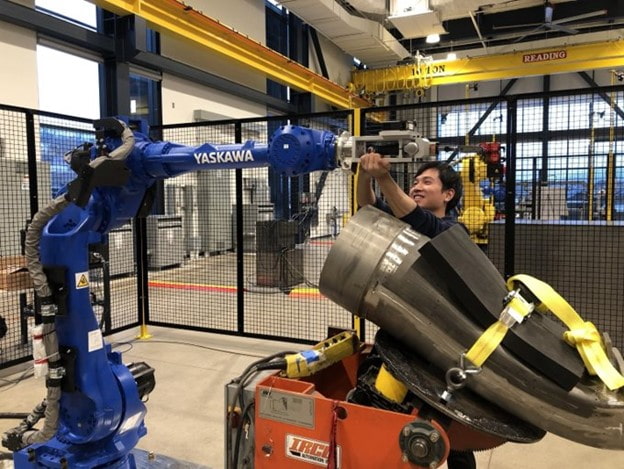Background
The polishing of large metallic parts is a critical manufacturing operation across various operations. The current process is predominantly completed manually. The objective of this project is the advancement and integration robot hardware and software to allow automatic onsite polishing. The limited robotic options that currently exist can only be applied to small workpieces and lack flexibility because the workpieces being polished must be held by a robotic arm. In this project’s approach, the surface is fixed while the grinding tool is held by the robotic arm.
Objective
Develop a flexible, low-cost robotic solution for surface treatment, particularly surface weld wash, grinding, and polishing.
Technical Approach
This project focused on an approach where the surface is fixed and the grinding tool is maneuvered by a robotic arm. To do this successfully, the following advancements will be critical:
- Alignment of the surface with a 3D model
- Initial measurement of surface roughness using a profilometer. The real time trajectory module will be used to generate the robot trajectory
- Determination of polishing parameters based on the initial measurement. The polish decision module will be used to determine the parameters using a set of rules stored in the library
- The trajectory planning module will be used to generate a trajectory for the approach of the area then the actual polishing
- The robot will use the profilometer to measure the roughness of the polished area and then report the quality of polishing
Impact
This project team designed a fully-automated, active compliance system that is able to successfully locate, measure, and remove the weld bead from the tube’s interior and verify process completion. Their system included external vision technology to identify the weld bead first. Once located, the multi-axis feedback from an ATI Force/Torque (F/T) Sensor enables the Yaskawa arm to measure and react to the weld-bead, determine the correct amount of pressure to apply, and remove the bead with the cutting tool. Finally, a profilometer verifies that the removal meets specifications.
The weld-bead removal system actually learns to improve based on the data it collects over time, which makes it very easy to program new parts and shapes. Low-volume, high-mix manufacturers want solutions that support the flexibility they need to stay competitive. The active compliance system streamlines the challenges of programming and executing heavy material removal and irregular shaped parts safely and efficiently, with room to grow.
Participants
Carnegie Mellon University (Principal Investigator), Siemens, Yaskawa Motoman

